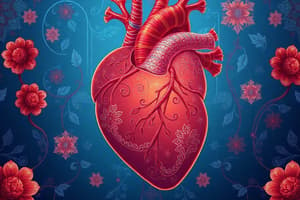Podcast
Questions and Answers
Which part of the nervous system regulates the visceral activity and supplies smooth muscles, cardiac muscle, and glands?
Which part of the nervous system regulates the visceral activity and supplies smooth muscles, cardiac muscle, and glands?
The autonomic nervous system.
What is the function of the sympathetic nervous system?
What is the function of the sympathetic nervous system?
The sympathetic nervous system prepares the body for fight or flight situations, increases heart rate and strength of heart beat, dilates coronary arteries, constricts peripheral arteries, relaxes bronchial smooth muscles, and controls body temperature.
What is the function of the parasympathetic nervous system?
What is the function of the parasympathetic nervous system?
The parasympathetic nervous system promotes rest and digestion, slows breathing and heart rate, stimulates digestion and secretion of digestive enzymes, opens sphincters, constricts pupils, and regulates body temperature.
Where are the cell bodies of the preganglionic neurons located in the autonomic nervous system?
Where are the cell bodies of the preganglionic neurons located in the autonomic nervous system?
Where are the cell bodies of the postganglionic neurons located in the autonomic nervous system?
Where are the cell bodies of the postganglionic neurons located in the autonomic nervous system?
Describe the course and distribution of the right and left vagus nerves.
Describe the course and distribution of the right and left vagus nerves.
Describe the clinical importance of the anatomy of the left recurrent laryngeal nerve.
Describe the clinical importance of the anatomy of the left recurrent laryngeal nerve.
Describe the position and extent of the sympathetic trunks and ganglia.
Describe the position and extent of the sympathetic trunks and ganglia.
Describe the functions of the sympathetic trunks and their branches.
Describe the functions of the sympathetic trunks and their branches.
State the signs of Horner’s syndrome.
State the signs of Horner’s syndrome.
Name the four broad categories of events from which dysrhythmias arise.
Name the four broad categories of events from which dysrhythmias arise.
What is the mechanism of action of class 1 sodium channel blockers?
What is the mechanism of action of class 1 sodium channel blockers?
What are the clinical uses of class 2 beta blockers?
What are the clinical uses of class 2 beta blockers?
What is the Vaughan Williams classification of anti-dysrhythmic drugs?
What is the Vaughan Williams classification of anti-dysrhythmic drugs?
What is meant by 'use-dependent' block?
What is meant by 'use-dependent' block?
What are the mechanism of action and uses of Class IV anti-dysrhythmic drugs?
What are the mechanism of action and uses of Class IV anti-dysrhythmic drugs?
Explain the mechanism of action of Class 4 drugs in the treatment of supraventricular dysrhythmias.
Explain the mechanism of action of Class 4 drugs in the treatment of supraventricular dysrhythmias.
What are the clinical uses of Class 4 drugs?
What are the clinical uses of Class 4 drugs?
What is the role of adenosine in terminating supraventricular tachycardias?
What is the role of adenosine in terminating supraventricular tachycardias?
What are the effects and clinical uses of digoxin?
What are the effects and clinical uses of digoxin?
What are the three factors that can shrink the window of coronary blood flow through the left ventricle?
What are the three factors that can shrink the window of coronary blood flow through the left ventricle?
What are the three causes of coronary ischaemia?
What are the three causes of coronary ischaemia?
What are the characteristics of angina pectoris?
What are the characteristics of angina pectoris?
Explain the difference between stable angina and unstable angina.
Explain the difference between stable angina and unstable angina.
What is variant (Prinzmetal) angina and what causes it?
What is variant (Prinzmetal) angina and what causes it?
What are the main treatments for angina to reduce chest pain symptoms?
What are the main treatments for angina to reduce chest pain symptoms?
Explain the vasodilator effect of verapamil and diltiazem and their clinical uses in angina.
Explain the vasodilator effect of verapamil and diltiazem and their clinical uses in angina.
What are the side effects of CCBs and what are their other clinical uses?
What are the side effects of CCBs and what are their other clinical uses?
What is the mechanism of action of nicorandil and what are its uses?
What is the mechanism of action of nicorandil and what are its uses?
What are the mechanisms of action of ivabradine and ranolazine?
What are the mechanisms of action of ivabradine and ranolazine?
Flashcards are hidden until you start studying




